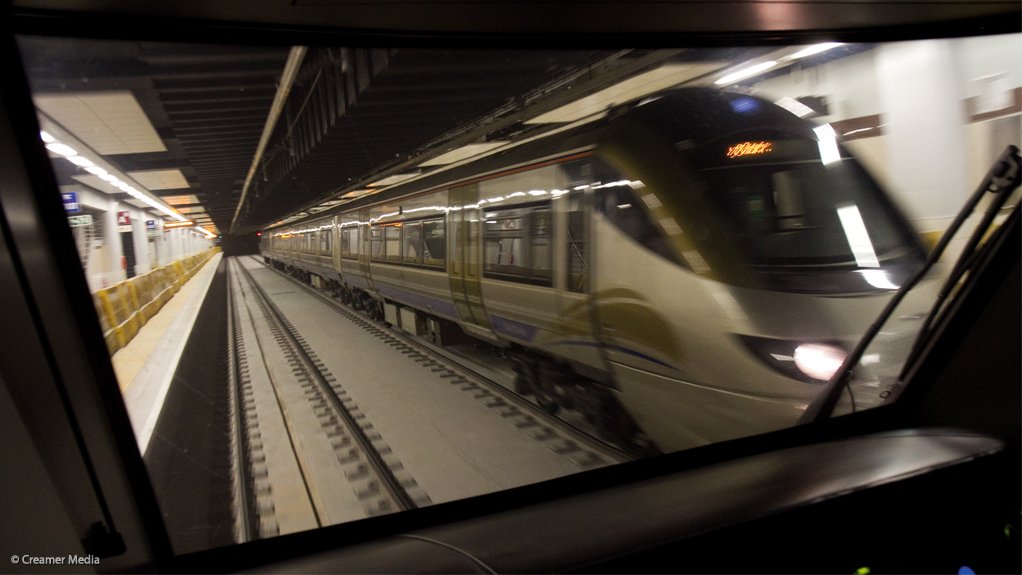As yet, no specific methodology, timeline or costs have been finalised to remedy the water ingress, excessive to contractual specifications, into the Gautrain tunnel between emergency shaft two (E2) and Park Station, says Bombela Concession Company technical and marketing executive Errol Braithwaite.
An arbitration tribunal in November 2013 ruled on the tunnel water ingress dispute between the Gauteng provincial government and the Bombela Concession Company, ordering Bombela to undertake remedial work on the Gautrain tunnel section between Johannesburg Park Station and E2, to stem the inflow of water into the tunnel.
Emphasising that the functionality and safe operation of the rail system is not threatened by the inflow of water into the tunnel, the tribunal also found that the tunnel section between Johannesburg Park Station and E2, as well as the section between the Rosebank Station and the Marlboro portal, has not been built in accordance with the contract specifications, as detailed in the concession agreement.
Bombela built and now operates the Gautrain project on behalf of the Gauteng government.
Options to comply with the arbitration determination have been the subject of an intense study by a panel of local and international technical experts, and a report on the matter was submitted to Bombela and the Gautrain Management Agency (GMA) in July last year, explains Braithwaite.
“The way forward is now being considered and will be agreed in the best interests of the project between the province, Bombela and the sub-contractors responsible for the work.”
Braithwaite notes that most of the tunnels on the Gautrain project have been designed and constructed as drained tunnels.
“This is a common international approach and means that the tunnel is designed specifically to allow limited amounts of groundwater to seep into a purpose-built drainage system inside the tunnel to relieve external hydrostatic pressures.
“The water is collected in drains constructed below and to the side of the track structure. These drains lead to underground sumps from where the water is pumped to surface and discharged. The quality of the discharged water is monitored on a monthly basis and has been of a consistently high standard.”
In accordance with this design approach, the presence of water in the Gautrain tunnel drains does not affect train operations in any way, nor the safety or integrity of the tunnels themselves, states Braithwaite.
“This is confirmed by the safety certification of the Gautrain system by the Railway Safety Regulator, as well as by an independent certifier.”
GMA CEO Jack van der Merwe indicated in November 2013 that while the inflow of water into the Gautrain tunnel does not endanger the Gautrain operating system in the short term, government remains concerned about the longer-term impacts this may have on the environment, as well as the operating system.
“Rail tunnels last for 100 years; however, the concession period is only 15 years. Therefore, the concessionaire has a much shorter timeframe in mind when they look at the tunnel, while we, as government, will stay the owner of the project for the next 100 years and, therefore, we are saying that this [inflow of water] is unacceptable.”
The GMA oversees Gautrain operations on behalf of the Gauteng government.
According to the overall tunnel specifications, the water flowing into the tunnels has to be limited to 1 ℓ per 1 m2 a day, while local specifications for the specific section of the tunnel affected require a water inflow limit of 10 ℓ for every 10 m of tunnel every minute.
Water ingress into the tunnel connecting Park Station and the Rosebank Station has been a contentious issue since the outset of development, delaying the opening of this leg of the Gautrain route by some four months in 2011.
EMAIL THIS ARTICLE SAVE THIS ARTICLE
To subscribe email subscriptions@creamermedia.co.za or click here
To advertise email advertising@creamermedia.co.za or click here











